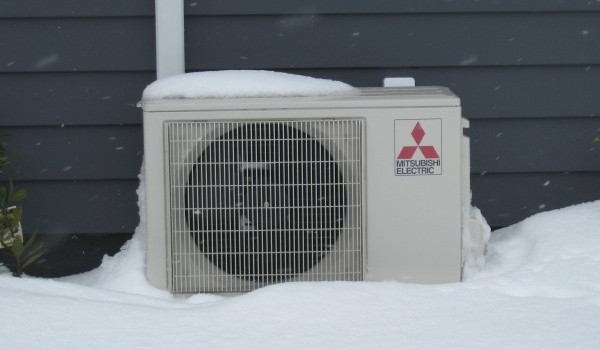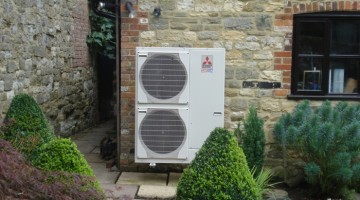
Ed, is a pilot and has recently bought a Victorian property with his wife just south of Reading. He is quite conscious about the environment and his carbon footprint, but due to his job, he appreciates his carbon footprint is not where he would like it to be.
Over the next few months, he will be writing a regular blog for us, sharing the steps he is taking to make his home more energy efficient and his life more environmentally sustainable.
 Ed’s Blog: Air Source Heat Pumps
Ed’s Blog: Air Source Heat Pumps
Christmas maybe over, but with more cold snaps being forecast, it looks like winter is stretching out for a few months yet! Typical for January, everyone appears busy adhering to their new year’s resolutions and I am no different. Two of my resolutions for this year are to reduce my carbon footprint and to get a better hold on my personal finances!
I’ve heard lots about air source heat pumps (ASHP), and I was wondering if they would work on my property. So earlier this week I talked to an installation company about the prospect of installing an ASHP in my home and through this blog I am reporting back on what I found.
ASHPs are a brilliant way of extracting heat in air particles to warm buildings. They basically work like a refrigerator in reverse. In a fridge, you remove the heat from the air inside it, making the interior cool. This is why the pipes on the back of the fridge heat up, because they channel the heat to the outside. Air source heat pumps take heat from the air outside your home and channel it into a building, therefore warming it up.
Planning permission for heat pumps
So, I had this very lengthy conversation with the ASHP engineer and this is what he told me:
- Firstly there is no need to get any sort of planning permission for an air source heat pump if you live in England; ASHPs are considered a permitted development.
- The ASHP does however need to be situated at least a metre from the edge of the boundary of your property and it must also be in a place that doesn’t impact the external appearance of the building. (I think what he meant was that it would be better to place it on the side or round the back of the property, which would not affect the view of the house from the street).
- You just need an outside wall, so they can be installed on almost all properties; detached, semi-detached, terraced, bungalows and even flats.
- The pump itself isn’t very big. The one the engineer showed me measured about 3 ft high, 4 ft wide and just was less than 2ft deep, which according to him was sizeable enough to source my property.
The conversation got very technical and I was worried I would have to make additional investment such as installing new plumbing to be able to cope with this new system (understandably was getting concerned about the potential cost at this stage!). However those fears were allayed when I found out that the ASHPs can be fed into the current central heating system without much additional cost and effort.
In addition, I would say if you have a bit more to spend and are looking to upgrade your property throughout, ASHPs can also be used to heat water, both for use or to supply your new underfloor heating system.
The engineer also recommended that in parallel I ensure that I have the best possible insulation in my property, because ASHPs work best when they have this in place. Luckily, my property is pretty well insulated, and this was one of the attributes that I looked for before I decided to buy.
Cost of an Air Source Heat Pump
So the important figures for me are and what you will be interested in too is, ‘how much I money would I actually be saving’. He said: I would be looking to spend around £6,500 for the system, which would save me about £650/year. So in ten years it would have paid back. Further down the field, having a microgeneration system attached to a property is also a good selling point as I would expect that this feature would increase its market value.
The savings bit (above) covered off my personal finances checkbox and the other half of my resolution was also covered – installing an ASHP system would also reduce my carbon emissions by 5,400kg/year!
I’d like to add, the other advantage I have in the property is that I have electric heaters installed. This property feature according to the engineer would benefit more from an ASHP, than someone supplied with mains gas, because it would be cheaper to run.
Ensure MCS Accreditation of your Air Source Heat Pump
The good news is that if you buy your pump from a certified MCS installer it comes with a ten year warranty. ASHPs are relatively maintenance free, though the engineer did recommend having them serviced every three years or so. Some of the general maintenance I am confident I could do myself such as: making sure there is no growth near it; ensure inlets are free of debris and ensure there is a good airflow going into the system. I even reckon it would be quite easy to check the levels of antifreeze myself if someone showed me how to do it.
Make money via the renewable heat incentive!
A little further down the line (late 2013), there is also the government’s Renewable Heat Incentive (RHI) to think about. The RHI, when it comes in later this year would offer me between 6.9 and 11.5p for each kWh of heat energy that I produce. It’s hard to know exactly how much that would save me, but it’s got to be worth a few extra quid over the next few years.
So, all in all, I’m going to go for it. I’m lucky that I’ve got the right property with the right insulation levels, serviced by a relatively modern system, which will complement the heat pump. I’ll blog some more once it’s installed (end of February) and let you know how it’s going.











Hi Ed,
Great to read your blog and good to hear that more and more homeowners are looking towards greener technologies such as Air Source Heat Pumps. I just wanted to add as you did not mention it and I am not sure if you have been informed of this by the installer you contacted? But the installation will also qualify for just 5% VAT as an energy efficient improvement to your home; which the contractors can invoice you from source, meaning you don’t have to fill in a form to claim it back. Sadly until the renewable heat incentive comes in, this is the only form of incentive that there is to install greener technologies in your home. Please do feel free to get in touch if we can be of further assistance. Best Regards. Adam Raybould for Allen Air Conditioning Ltd.
Thanks Adam!
That 5% VAT is a definite bonus – I wasn’t aware of that. I have just spoken to the installation company again and they have confirmed that is correct and their figures above had already taken it into account. I now have a firm date at the end of February to begin the installation and after that I will look at applying for the RHI (Renewable Heat Incentive) scheme to see if I can get some money back from the government when it comes in at the end of the year.
I’m not sure still exactly how much I will get back – no one seems to know – but as soon as I do I will post on here. Good luck everyone!
A brilliantly informative post, Ed.
It’s really good to see how much thought you have put into getting a heat pump. They are definitely worth it with the carbon emission reduction and money saving. I hope your installation goes well and that you find plenty of other energy efficient improvements for your house.
Ed, I am also thinking to install air source heat pump in my house, but before that I go ahead I was looking for some practical knowledge on its installation. You post has everything for a newbie looking for installation. Thanks for sharing.
I am a strong advocate of heat pumps and recommend them whenever suitable. They have had some bad press over the past few years mainly because the system designers/installers have undersized the systems. All heat pumps produce low grade heat and need to run for long periods if not 24/7 to maintain comfortable temperatures and will only operate satisfactorily if the thermal envelop is to the highest standard i.e. the levels of insulation are at their highest. I have evidence of a 3 bedroom home converted from storage heaters to air to water reducing their total energy bill (space heating and hot water plus electrical items) by 75%
I am concerned with the misconception that they are ‘microgeneration’ systems. This term should be reserved for systems producing electicity only such as solar PV, wind turbines and micro-hydro. Heat pumps are a renewable heat system. Renewable energy systems in or on a home must increase resale value.
Hi Ed,
just picked up on your blog. It is good to see some open discussion about heat pumps, they are still so under the radar for most people. As you an guess I am all for them!
As a small note they are only permitted development if they fulfil two tests of noise level and volume, most are though.
On Eric’s point, a heat pump is just another heat source, it as with any other form needs to meet the buildings needs. Insulation will reduce the heat demand for a property and thus the size of heat pump or oil boiler needed, there is no scientific reason why a heat pump cannot supply any level of heat. There is a practical reason though, once you get above about 11kW of heat demand at cold temperatures the electrical load of the heat pump will be bigger than a normal single phase of electricity can offer at which point you need two pumps or three phase, which is expensive.
Until very recently I would not have suggested that many people of the gas grid should consider heat pumps as the cost of gas is so low. Strangely the RHI seems to be supporting this so it is not a fair idea if you are doing it to reduce emissions in a fairly cost effective way.
Hello,
It has been a while since you started this blog. Did you buy a heat pump? I bought one last year and although it suits me fairly well, I wouldn’t recommend them to everyone. They run 24 hours a day which is fine if (like me) you are at home all day but a waste if you aren’t. Most houses will need larger radiators as the water temperature produced by the heat pumps is only about 50C at best. When the outside temperature drops below freezing the heat pump has to work very hard to warm the house and is at its least efficient (it takes more energy to get heat out of cold air than warm air) My system looks likely to be cheaper than the oil fired boiler it replaced and the RHI should just about cover the cost of the installation but it isn’t nearly as economical as I was lead to believe.
Hi Gerald, Ed ended up installing a GSHP – 2 x 120m boreholes. They also used GDHIF to install EWI (with the £6k cashback). I will get in touch and get Lizzie or Ed to comment on how they are finding it.
Thanks for useful information, However I am concerned That an ASHP will not generate sufficient heat to keep my Victorian property warm via the existing radiator system. They will need to be twice the size apparently? Not sure what your system is?